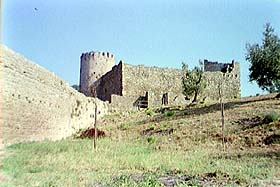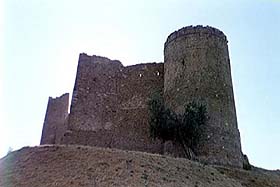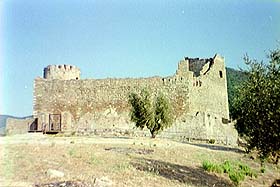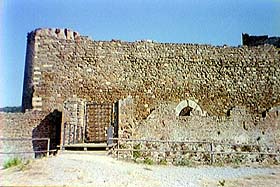Scarlino Castle
 |
 |
| The town walls connected at the castle in northeast angle. | The Southwest tower, at its left the front towards the sea. |
The castle of Scarlino dominates the homonym suburb, on a hill 230 meters high, in province of Grosseto. It is about six kilometers far from the coast of the Gulf of Follonica and is easily reachable following the SS1 Aurelia.
The importance of the town of Scarlino and its Castle is inherent in the etymology of the name: although some considers it derived by the Roman port called 'Porto Scabris' situated once on the neighbor coast, seems more probable the hypothesis of a link to the Longobard term 'Scherl', that means 'Sentinel'. In fact, thanks to the its extraordinary position, from which is possible to dominate each the whole underlying lowland and wide part of the coast from Piombino to Punta Ala, the Castle had in the history the important assignment to sight and to communicate the arrival of enemies from the sea to the cities of the inside.
 |
| The main front with the gate. |
The birth of the country and the construction of the fortification in an elevated and difficult to reach position instead that in the lowland next to the sea, more favorable for the commerce and the communications, was essentially due to the fact that, in the years immediately following at the collapse of the Roman Empire and in concomitance with the invasions of the northern populations, the same lowland had become an immense and unhealthy swamp, because of the combined action of the sea tides and the deposits of the river Pecora.
The first notices of a strengthened settlement called Scarlino goes back at the year 973, but it is impossible to establish what was its aspect at the time. Later the castle's ownership passed to the counts Alberti of Prato and Mangona and in 1164 it was conquered by the Pisane, that for a long time aimed to control this area for commercial purposes. Subsequently, around the year 1240, Scarlino was one of the first countries of the Maremma to organize itself as free common. In 1399 the city entered to belong to the municipality of Piombino where stayed up until 1814.
The actual 12th century look of the castle is owed to the noble Aldobrandeschi family of Sovana, that acquired Scarlino thanks to the marriage of Ildebrandino Aldobrandeschi with a daughter of the Count Alberto Alberti.
The castle has an irregular plant of five sides and was connected to the town walls with a wall line, partly disappearance, chained with Northwest angle of its main front, the less exposed of the fortification.
 |
| The gate on the outer defenses, once endowed with a drawbridge. |
External defenses constituted by a second wall track are present only on the two sides of the castle more easily accessible from the city - North and northeast - and these were endowed of battlement and protected from a ditch dug in the rock. On these two sides the internal enclosure of the fortification is not defended from towers, but there're remnants of brackets to testimony that the walls were endowed of machicoulis (opening between corbels of a parapet through which the defenders can drop rocks or fire projectiles against an enemy directly below them), at least in the northeast angle. The other three sides are turned to the sea and endowed of more elevated walled curtains and defended in every angle from a tower: the Southeast squared and more tall (being directly the only one with the turned front to the sea and acted at watch tower) and the South disposed as a 'spur' out of the walls to have the possibility of a draught fire from the loopholes. The tower of Southwest, surely the most ancient nucleus of the castle, is instead of square form and preserve the rests of the brackets from which it leaned the hoarding .
| Back to Homepage |
| Back to Castles Index |